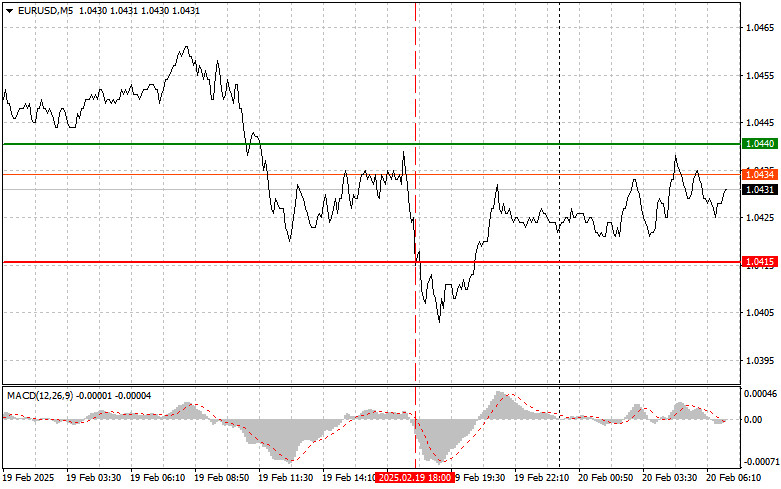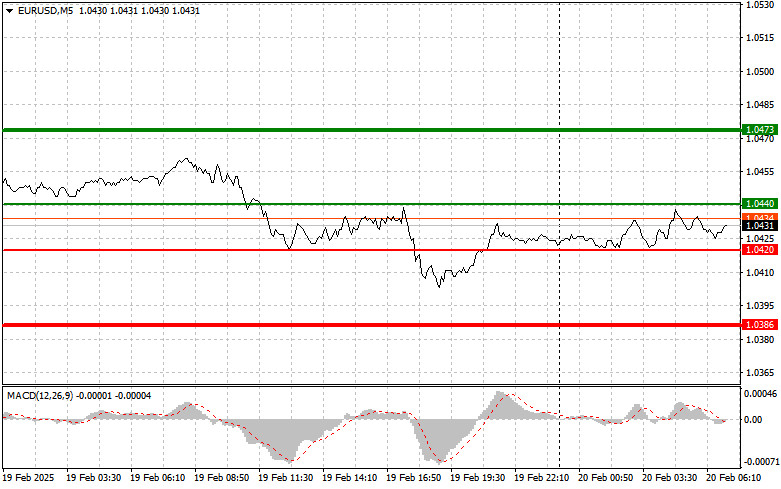Analysis of Trades and Trading Tips for the Euro
The price test at 1.0415 occurred when the MACD indicator had already significantly declined from the zero mark, which limited the pair's downward potential by the end of the day. For this reason, I chose not to sell the euro.
The FOMC minutes released yesterday confirmed the views already held by the Federal Reserve. Committee members believe there is no need to rush into rate cuts. Before making any decisions in this regard, the Fed wants to see real progress in controlling inflation. They also noted that rates will remain high if the economy shows signs of overheating again. This position is not new to the market or traders, so it did not result in a significant shift in positioning. However, it does put pressure on risk assets and supports the dollar.
Moving forward, attention will focus on inflation data, employment levels, and retail sales figures in the U.S. Sustained wage growth and strong consumer spending could indicate ongoing inflationary pressure, which may prompt the Fed to approach rate cuts with more caution.
No major data are scheduled this morning, so the focus should be on the German Producer Price Index (PPI) and the Eurozone Consumer Confidence Index. These indicators act as inflation signals and economic health metrics for the region. Stronger-than-expected PPI data in Germany could push the European Central Bank to adopt a more cautious approach to rate cuts, thereby strengthening the euro. Conversely, weak data could put pressure on the single currency.
The Consumer Confidence Index reflects household optimism about the economy's future. Higher confidence levels often signal increased consumer spending, stimulating economic growth and potentially supporting the euro.
As for the intraday strategy, I will mainly rely on implementing Scenarios #1 and #2 today.
Buy Signal
Scenario #1: Today, I plan to buy the euro when the price reaches 1.0440 (green line on the chart) with a target of 1.0473. At 1.0473, I plan to exit the trade and sell the euro in the opposite direction, expecting a 30-35 pip retracement from the entry point. A bullish move in the first half of the day is only likely if we see strong economic data from Germany. Important! Before entering a buy trade, ensure that the MACD indicator is above the zero mark and starting to rise.
Scenario #2: I will buy the euro today if the price tests 1.0420 twice while the MACD indicator is in the oversold zone. This will limit the pair's downside potential and likely trigger a reversal to the upside. The expected upside targets are 1.0440 and 1.0473.
Sell Signal
Scenario #1: I plan to sell the euro after reaching 1.0420 (red line on the chart), aiming for 1.0386, where I will exit the trade and immediately buy in the opposite direction, expecting a 20-25 pip retracement. Selling pressure will increase if economic data disappoints. Important! Before entering a sell trade, ensure that the MACD indicator is below the zero mark and starting to decline.
Scenario #2: I will also sell the euro today if the price tests 1.0440 twice while the MACD indicator is in the overbought zone. This will limit the pair's upside potential and likely trigger a reversal downward. The expected downside targets are 1.0420 and 1.0386.
What's on the Chart:
- The thin green line represents the entry price where the trading instrument can be bought.The thick green line indicates the expected price level where a Take Profit order can be placed, or profits can be manually secured, as further price growth above this level is unlikely.The thin red line represents the entry price where the trading instrument can be sold.The thick red line indicates the expected price level where a Take Profit order can be placed, or profits can be manually secured, as further price decline below this level is unlikely.The MACD indicator should be used to assess overbought and oversold zones when entering the market.
Important Notes:
- Beginner Forex traders should exercise extreme caution when making market entry decisions. It is advisable to stay out of the market before the release of important fundamental reports to avoid exposure to sharp price fluctuations. If you choose to trade during news releases, always use stop-loss orders to minimize potential losses. Trading without stop-loss orders can quickly wipe out your entire deposit, especially if you neglect money management principles and trade with high volumes.
- Remember, successful trading requires a well-defined trading plan, similar to the one outlined above. Making impulsive trading decisions based on the current market situation is a losing strategy for intraday traders.














